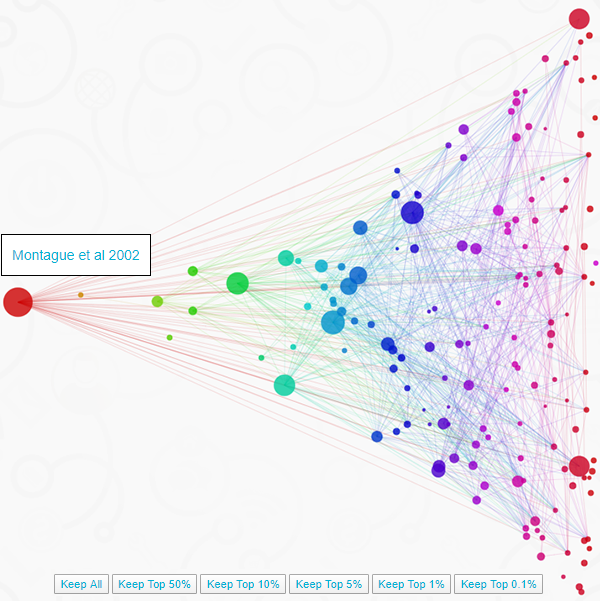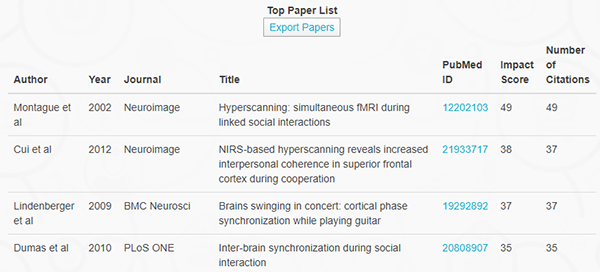
Citation Network
There are thousands of papers in my field, but which ones are important? How to identify key papers in a limited time when I am new to a field? "Citation Network" allows researchers to quickly identify the classic / important papers in a field within a few minutes and do more research with less effort.
Below, we use "hyperscanning" (a technology in brain science) as a keyword to demonstrate the citation network in this field. Here is a screen shot:

After entering the keyword, Stork searched and analyzed 154 related publications in real time, and then made a network graph of the relationship between them. Each point is an article, arranged from left to right by publication date (the oldest is on the left). The size of the points is proportional to the impact score of the papers. The impact score is, in most cases, the number of times the article has been cited (by papers limited to the keyword); but for the newly published papers, the impact factor of the publishing journal is added because it has not been cited yet. It is very clear from the diagram which are important articles. For example, the big point on the far left is the classic article by Montague in 2002 who was the pioneer in hyperscanning.
This graph, as well as individual papers inside it, can be dragged and zoomed in/out with the mouse. After clicking on an point, the information (author and year) of the paper will appear. Click again and the abstract page will be loaded.
What if the number of papers is large? When the number of papers is several thousand, the points will be very dense, and the important papers become difficult to visually identify. In this case, you may click on the buttons below the graph to limit the number of papers shown. For example, clicking on button "Keep TOP 5%" will only keep the top 5% of the papers in the graph.

If you want to analyze a single paper's citations, you may enter the paper's PubMed ID or DOI into the search box. For example, if you enter 21047559, Stork will download papers who cited the target paper, as well as the papers the target paper cited, and analyze their relationship.
Stork also lists the detailed of these papers (up to Top 1000) below the graph, including author, year, journal, number, title, PubMed ID, impact factor and citation numbers. By clicking the PubMed ID you find the abstract. In addition, if you want to download all papers, click on “Export Papers” button, and the list will be downloaded as CSV file which can be opened in Excel or other programs.
Note
The citation data is from PubMed. Compared to Google Scholar or Web of Science, the data is not as comprehensive. But it is adequate for the purpose of finding important literatuers.
Benefits
From the above example, it can be seen that the citation network has the following benefits for researchers and students:
- Identify the classic papers in a field quickly
- Provide a handy tool when writing review articles
- Read the most important articles in a limited time
How to use?
Please go to Stork main page (account required), scroll down to the Advanced Feature section, check the "Add to subscription" box and then click "Subscribe" Button. You may also purchase Stork Membership.
Your payment is processed securely via Stripe.
Other advanced features
- AI Paper
- Writing Assistant
- ChatPaper
- True Cite
- Stork Pro
- Email Translate
- NIH Grant Database: Search, Translate & Alert
- PubMed Multi-Language Search, Translate & Alert
- Big Analysis
- Citation Network
- Preprint Alert
- Sentence Sea
- Listen to papers
- Journal Finder
- Reading Guide
Stork Official Website: https://www.storkapp.me
